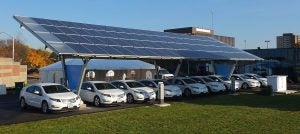 Customer interest and adoption of clean energy technologies, including solar and electric vehicles (EVs), has increased significantly in recent years. People across the country have already taken steps to become more engaged in energy decisions that impact their homes, wallets, and communities. However, questions about the future of these developing technology options still remain. How do we ensure each customer is able to participate and benefit from making clean energy choices? How can this growth be sustained? What do customers really think about these clean technologies today?
Customer interest and adoption of clean energy technologies, including solar and electric vehicles (EVs), has increased significantly in recent years. People across the country have already taken steps to become more engaged in energy decisions that impact their homes, wallets, and communities. However, questions about the future of these developing technology options still remain. How do we ensure each customer is able to participate and benefit from making clean energy choices? How can this growth be sustained? What do customers really think about these clean technologies today?
A new report from the Smart Grid Consumer Collaborative (SGCC) attempts to address some of these questions and present a closer view of customer attitudes towards clean energy, electric vehicles, and the electric grid by going straight to the source. SGCC partnered with DNV GL, CenterPoint Energy, and Environmental Defense Fund (EDF) to survey over 1,500 people across the United States to see what customers really think about these technologies. Many of the findings are surprising and suggest that the decreasing costs of home solar and electric vehicles, coupled with consumer interests in clean energy and staying connected to the grid, present business cases for promotional and educational campaigns.
[Tweet “What Do Customers Want from Solar and Electric Vehicles? Surprising New Survey Results”]
Key takeaways and opportunities for clean energy technology
We encourage you to take a look at the full set of findings (and the webinar overviewing them), but the following are a few that stand out:
- Promotional and education opportunities: Less than 22 percent of customers believed they had a “fairly complete understanding” of solar and EV technologies. This lack of familiarity with the technologies and the benefits they can provide is one of the most significant barriers to customer adoption. Most customers have to search exhaustively for information and spend time, money, and effort just to engage with these energy options. This finding points to a significant opportunity to address the gap in understanding through greater promotion and customer education efforts. These efforts can and should include publicly-supported programs.
- Cost still matters: The upfront costs associated with these technologies continue to be a barrier to customer adoption. Demographic characteristics, such as homeownership and income level, still strongly correlate with whether customers engage with these energy options or not. Fortunately, capital costs associated with solar have significantly decreased over the last decade. What’s more, a broader range of EV options are now available to the mass market. In addition, “sharing economy” options such as community solar (where a community or multiple customers share ownership in the electricity produced from a solar power plant) and green power plans (in which customers buy clean energy from a market) are showing traction. These options allow customers with limited roof space or investment capital, or who rent instead of own their home, to participate in the clean energy economy.
- The electric grid still matters: Even though customers demonstrated a willingness to adopt and explore clean energy options, they still value being connected to the electric grid as a “back-up” power source and were willing to pay for it. In addition, some customers were more interested in electric vehicles when coupled with time-of-use electricity rates that are favorable to EV owners. This innovative pricing tool – which changes the price of electricity depending on the time of day and the demand on the electric grid – paired with EVs can help people save money when charging their vehicles and use electricity when it’s less costly or provided by clean, renewable sources.
Just the beginning
Not only can advances in clean energy technologies provide significant benefit for customers that directly adopt them, but they can also contribute to a modernized electric grid that benefits all. A modern grid can make the electric system more efficient, increase the penetration of renewables, reduce greenhouse gas emissions, and provide cleaner air for all.
SGCC’s research goes a long way in providing a closer look into customer views around clean energy technologies. Energy leaders should look to these findings to not only recognize the opportunities to enhance the services they provide, but also to understand customer market trends. Both will help us better plan for a more modern, sustainable energy system.
This post originally appeared on the Smart Grid Consumer Connections blog.
Photo source: Sass Peress, Renewz Sustainable Solutions Inc.










One Comment
With technology today why can’t we make cars charge themselves up by driving?